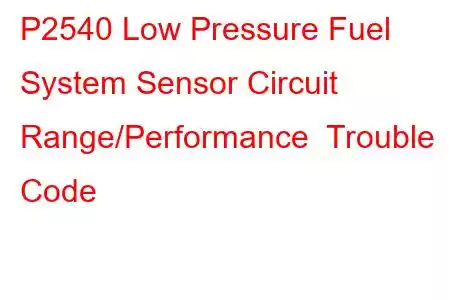Home » P2500-P2599 Codes » P2540 P2540 Low Pressure Fuel System Sensor Circuit Range/Performance
OBD-II Trouble Code Technical Description
Low Pressure Fuel System Sensor Circuit Range/Performance
What does that mean?
This generic powertrain/engine diagnostic trouble code can typically apply to all OBDII equipped engines, but shows up more often in certain Audi, Ford and VW vehicles.
The Fuel Pressure Sensor (FPS) is usually found directly mounted into the fuel rail, close to the injectors and the intake manifold. The FPS converts the system fuel pressure into an electrical signal for the Powertrain Control Module (PCM).
The PCM receives this voltage signal and possibly one more; Fuel Temperature Sensor (FTS) which may or may not be part of the FPS. The PCM looks at the FPS sensor voltage to determine the exact amount of fuel to inject into the engine. This code is set if this input does not match normal engine operating conditions stored in the PCM’s memory.
It also looks at the voltage signal from the FPS sensor to determine if it is correct at initial Key On Engine Off. This code could have been set because of mechanical (typically fuel pressure/volume) or electrical (fuel pressure sensor circuit) issues.
Troubleshooting steps may vary depending upon manufacturer, type of FPS/FTS sensor and wire colors.
Symptoms
Symptoms of a P2540 engine code may include:
Malfunction Indicator Light On Possible no start Longer than normal crank times Hesitation during acceleration Decrease in fuel economyCauses
Potential causes for this code to set are:
Open in the signal circuit to the FP sensor Short to voltage in the signal circuit to the FP sensor Short to ground in the signal circuit to the FP sensor Open in power or ground at FP sensor Failed FP Sensor - possible Failed PCM - unlikelyDiagnostic and Repair Procedures
A good starting point is always to check for technical service bulletins (TSB) for your particular vehicle. Your issue may be a known issue with a known fix put out by the manufacturer and can save you time and money during diagnosis.
Next, locate the FPS sensor on your particular vehicle. This sensor is usually found directly screwed / mounted into the fuel rail, close to the injectors and the intake manifold. Once located, visually inspect the connector and wiring. Look for scraping, rubbing, bare wires, burn spots or melted plastic. Pull the connector apart and carefully inspect the terminals (the metal parts) inside the connector. See if they look burned or have a green tint indicating corrosion. Use electrical contact cleaner and a plastic bristle brush if cleaning of the terminals is needed. Let dry and apply electrical grease where the terminals contact.
If you have a scan tool, clear the diagnostic trouble codes from memory, and see if P2540 code returns. If it does not, then the connections were most likely your problem.
If the P2540 code does return, insure that you have good fuel pressure by testing with a mechanical gauge. Check with the manufacturers specs for your vehicle. If the fuel pressure and volume do not pass, replace the fuel pump, clear codes and retest. If the P2540 is now gone, then the problem was mechanical.
If the P2540 code does return, we will need to test the FPS sensor and its associated circuits. With the Key Off, disconnect the electrical connector at the FP sensor. Connect a Digital Voltmeter black lead to the ground terminal at the FP sensor wiring harness connector. Connect the red lead of the Digital Voltmeter to the power terminal at the FP sensor wiring harness connector. Turn Key On Engine Off. Check manufacturer’s specifications; voltmeter should read either 12 volts or 5 volts. If not, repair open in wiring on the power or ground wire, or replace the PCM.
If the prior test passed, we
Read: 23


